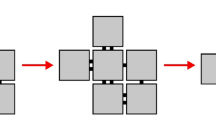Abstract
We present DNA components whose 3D geometry and cohesive portions are compatible with a fractal 3D assembly. DNA parallelograms have been proposed in Carbone and Seeman [(2002b) Natural Computing 1: 469–480; (2003) Natural Computing 2: 133–151] as suitable building blocks for a 2D fractal assembly of the Sierpinski carpet. Here we use Mao 3D triangles, which are 3D geometrically trigonal molecules, to construct basic building blocks and we obtain a simplified version of the 2D assembly design. As in the previous 2D construction, we utilize the interplay of coding in the form of cohesive ends, geometrical complementarity and protection of potentially undesirable sites of reactivity. The schema we propose works for trigonal symmetries and the Mao triangle is one example of a possible DNA trigonal tile.
Similar content being viewed by others
References
Carbone A and Seeman NC (2002b) A route to fractal DNA assembly. Natural Computing 1: 469–480
Carbone A and Seeman NC (2002a) Circuits and programmable self-assembling DNA structures. Proceeding of the National Academic Sciences (USA) 99: 12577–12582
Carbone A and Seeman NC (2003) Coding and geometrical shapes in nanostructures: A fractal DNA-assembly. Natural Computing 2: 133–151
Chen J and Seeman NC (1991) The synthesis from DNA of a molecule with the connectivity of a cube. Nature 350: 631–633
Churchill MEA, Tullius TD, Kallenbach NR and Seeman NC (1988) A Holliday recombination intermediate is twofold symmetric. Proceedings of the National Academic of Science (USA) 85: 4653–4656
Eichman BF, Vargason JM, Mooers BHM and Ho PS (2000) The Holliday junction in an inverted repeat DNA sequence: sequence effects on the structure of four-way junctions. Proceedings of the National Academic Science USA 97: 3971–3976
Fu T-J and Seeman NC (1993) DNA double crossover structures. Biochemistry 32: 3211–3220 (1993)
Hagerman PJ (1988) Flexibility of DNA. Annual Review in Biophyics and Biophysical Chemistry 17: 265–286
Holliday R (1964) A mechanism for gene conversion in fungi. Genetics and Research 5: 282–304
Mao C, Sun W and Seeman NC (1999) Designed two-dimensional DNA Holliday junction arrays visualized by atomic force microscopy. Journal of the American Chemical Society 121: 5437–5443
Mao C, LaBean T, Reif JH and Seeman NC (2000) iLogical computation using algorithmic self-assembly of DNA triple crossover molecules. Nature 407: 493–496
Sa-Ardyen P, Vologodskii AV and Seeman NC (2003a) The flexibility of DNA double crossover molecules. Biophysics Journal 84: 3829–3837
Sa-Ardyen P, Jonoska N and Seeman NC (2003b) Self-assembling DNA graphs. In: DNA-Based Computers VIII, LNCS 2568, pp. 1–9. Springer-Verlag, Berlin
Schrödinger E (1944) What is Life? and Mind & Matter. Cambridge University Press, London (republished, 1967)
Seeman NC (2003) DNA in a material world. Nature 421: 33–37
Sha R, Liu F, Millar DP and Seeman NC (2000) Atomic force microscopy of parallel DNA branched junction arrays. Chemistry and Biology 7: 743–751
Sha R, Liu F and Seeman NC (2002) Atomic force measurement of the inter-domain angle in symmetric Holliday junctions, Biochemistry 41: 5950–5955
Yan H, Zhang X, Shen Z and Seeman NC (2002) A robust DNA mechanical device controlled by hybridization topology. Nature 415: 62–65
Yurke B, Turberfield AJ, Mills AP Jr., Simmel FC and Neumann JL (2000) A DNAfueled molecular machine made of DNA. Nature 406: 605–608
Zhang Y and Seeman NC (1994) The construction of a DNA truncated octahedron. Journal of the American Chemical Society 116: 1661–1669
Author information
Authors and Affiliations
Corresponding author
Rights and permissions
About this article
Cite this article
Carbone, A., Mao, C., Constantinou, P.E. et al. 3D Fractal DNA Assembly from Coding, Geometry and Protection. Natural Computing 3, 235–252 (2004). https://doi.org/10.1023/B:NACO.0000036819.42166.1a
Issue Date:
DOI: https://doi.org/10.1023/B:NACO.0000036819.42166.1a




